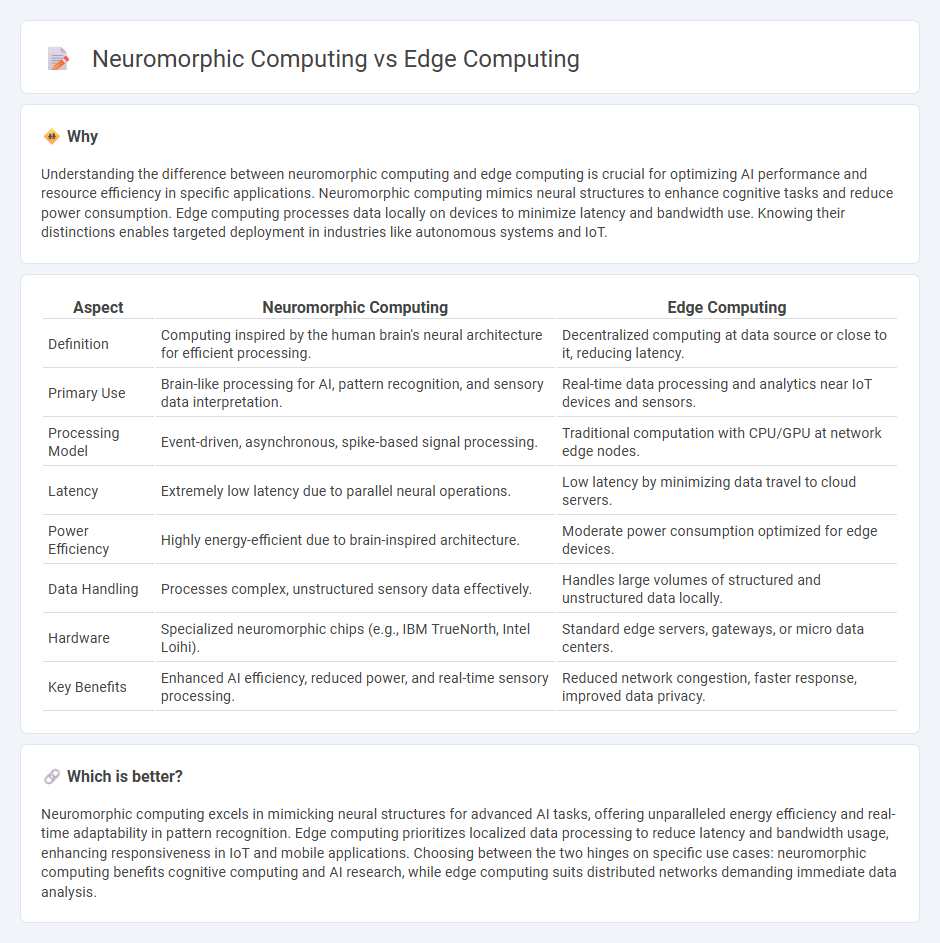
Neuromorphic computing emulates brain-like neural architectures to optimize data processing and energy efficiency in AI applications, while edge computing focuses on decentralizing computational tasks closer to data sources for reduced latency and increased privacy. Both technologies address the limitations of traditional cloud computing by enhancing real-time processing capabilities and supporting a growing ecosystem of IoT devices. Explore the unique advantages and potential synergies of neuromorphic and edge computing to understand their impact on future technology landscapes.
Why it is important
Understanding the difference between neuromorphic computing and edge computing is crucial for optimizing AI performance and resource efficiency in specific applications. Neuromorphic computing mimics neural structures to enhance cognitive tasks and reduce power consumption. Edge computing processes data locally on devices to minimize latency and bandwidth use. Knowing their distinctions enables targeted deployment in industries like autonomous systems and IoT.
Comparison Table
| Aspect | Neuromorphic Computing | Edge Computing |
|---|---|---|
| Definition | Computing inspired by the human brain's neural architecture for efficient processing. | Decentralized computing at data source or close to it, reducing latency. |
| Primary Use | Brain-like processing for AI, pattern recognition, and sensory data interpretation. | Real-time data processing and analytics near IoT devices and sensors. |
| Processing Model | Event-driven, asynchronous, spike-based signal processing. | Traditional computation with CPU/GPU at network edge nodes. |
| Latency | Extremely low latency due to parallel neural operations. | Low latency by minimizing data travel to cloud servers. |
| Power Efficiency | Highly energy-efficient due to brain-inspired architecture. | Moderate power consumption optimized for edge devices. |
| Data Handling | Processes complex, unstructured sensory data effectively. | Handles large volumes of structured and unstructured data locally. |
| Hardware | Specialized neuromorphic chips (e.g., IBM TrueNorth, Intel Loihi). | Standard edge servers, gateways, or micro data centers. |
| Key Benefits | Enhanced AI efficiency, reduced power, and real-time sensory processing. | Reduced network congestion, faster response, improved data privacy. |
Which is better?
Neuromorphic computing excels in mimicking neural structures for advanced AI tasks, offering unparalleled energy efficiency and real-time adaptability in pattern recognition. Edge computing prioritizes localized data processing to reduce latency and bandwidth usage, enhancing responsiveness in IoT and mobile applications. Choosing between the two hinges on specific use cases: neuromorphic computing benefits cognitive computing and AI research, while edge computing suits distributed networks demanding immediate data analysis.
Connection
Neuromorphic computing enhances edge computing by mimicking neural architectures to process data locally with high efficiency and low latency. This synergy allows edge devices to perform complex cognitive tasks such as pattern recognition and real-time decision-making without relying heavily on cloud resources. Integrating neuromorphic chips into edge platforms accelerates AI applications, optimizes power consumption, and improves privacy by minimizing data transmission.
Key Terms
Latency
Edge computing reduces latency by processing data closer to the source, minimizing the time required for data transmission to centralized servers. Neuromorphic computing achieves ultra-low latency through hardware designed to mimic neural networks, enabling rapid asynchronous data processing and real-time responsiveness. Explore the advantages and applications of both computing paradigms to understand their impact on latency-sensitive tasks.
Architecture
Edge computing architecture decentralizes processing by bringing computation and data storage closer to the data source, enhancing real-time analytics and reducing latency. Neuromorphic computing architecture mimics the neural structure of the human brain, using spiking neural networks and specialized hardware to enable energy-efficient, adaptive processing. Explore deeper into how these architectures uniquely impact performance and application domains.
Real-time processing
Edge computing enables real-time processing by minimizing data transfer latency through decentralized processing near the data source, ideal for IoT and autonomous systems. Neuromorphic computing mimics neural architectures to deliver ultra-fast, low-power real-time processing, especially beneficial in complex sensory data interpretation and adaptive learning. Explore deeper insights into how these technologies revolutionize real-time processing in advanced applications.
Source and External Links
What is Edge Computing? - Edge computing is a technology that processes data closer to the user, reducing latency and improving efficiency by handling data at the "edge" of the network.
What is Edge Computing? - Edge computing brings computing closer to the source of data, reducing latency and bandwidth use by processing data locally.
What Is Edge Computing? - Edge computing allows devices to process data at the "edge" of the network in real-time, minimizing latency by sending only relevant data to the central datacenter.
 dowidth.com
dowidth.com